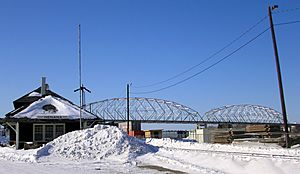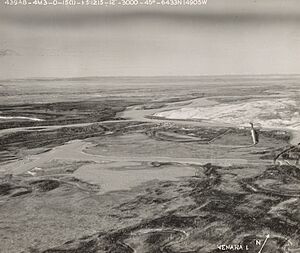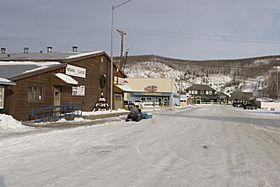Nenana, Alaska facts for kids
Quick facts for kids
Nenana
Toghotili
|
|
|---|---|

Nenana train station and Parks Highway bridge
|
|
| Country | United States |
| State | Alaska |
| Census Area | Yukon-Koyukuk |
| Incorporated | November 17, 1921 |
| Area | |
| • Total | 6.25 sq mi (16.18 km2) |
| • Land | 5.95 sq mi (15.42 km2) |
| • Water | 0.29 sq mi (0.76 km2) |
| Elevation | 351 ft (107 m) |
| Population
(2020)
|
|
| • Total | 358 |
| • Density | 60.14/sq mi (23.22/km2) |
| Time zone | UTC-9 (Alaska (AKST)) |
| • Summer (DST) | UTC-8 (AKDT) |
| ZIP code |
99760
|
| Area code | 907 |
| FIPS code | 02-53050 |
| GNIS feature ID | 1406940 |
Nenana is a small city in Interior Alaska, part of the Yukon-Koyukuk Census Area. It is located where the Nenana River flows into the larger Tanana River. This area has long been home to the Tanana Athabaskans, an Indigenous group. In 2020, about 358 people lived in Nenana.
A very important part of Nenana is the Mears Memorial Bridge. This bridge, built in 1923, is 700 feet long. It crosses the Tanana River and is a key part of the railroad system in Alaska.
Contents
History and Culture of Nenana
Nenana is in the traditional lands of the Tanana Athabaskans. These people are part of a larger group called the Dené language family. Early European visitors called the town Tortella. This name came from the Native word Toghotthele, which means "mountain that runs next to the river." Later, the town was named after the Nenana River and the local people.
Early Contact and Gold Rush
The Nenana people had contact with Europeans for a long time. They traded furs for Western goods with Russians starting in 1838. The United States bought Alaska from Russia in 1867. American explorers and traders first came to the Tanana Valley in the late 1800s.
In 1902, gold was found in Fairbanks, which brought many people to the area. The next year, Jim Duke built a trading post in Nenana. This post supplied river travelers and traded with the local community.
Schools and Missions
In 1905, the Episcopal Church built the St. Mark's Episcopal mission and Tortella School. This boarding school was a short distance upriver. It taught about 28 children at a time. Many Native children from nearby communities, like Minto, also went to school in Nenana.
The Alaska Railroad and Growth
A post office opened in Nenana in 1908. In 1915, the building of the Alaska Railroad brought many new settlers. This caused Nenana's population to double. The railroad connected Nenana to Anchorage, a port city to the south. Nenana officially became a city in 1921.
The Railroad Depot was finished in 1923. That same year, U.S. President Warren Harding visited. He drove the final, golden spike to complete the Mears Memorial Bridge. This bridge was the longest railroad truss bridge in the United States when it was built. It connected Nenana by rail to Fairbanks in the north and Seward, Alaska in the south.
Changes After Railroad Completion
The railroad construction made Nenana grow quickly. In the early 1920s, about 5,000 people lived there. But after the railroad was finished, many workers left. The city's economy slowed down, and its population dropped to 291 by 1930.
Nenana was also important in the 1925 serum run to Nome. This famous event involved transporting medicine by dog sled to Nome. The medicine was needed to fight a serious illness called diphtheria.
Modern Connections and Floods
In 1968, a new bridge for cars was built across the Tanana River. This bridge gave Nenana a modern road link to Fairbanks. It replaced the old river ferry. The George Parks Highway was completed in 1971. This highway gave Nenana a shorter, direct road to Anchorage.
In 1967, a very large flood hit Nenana. It was one of the biggest floods ever recorded in the valley.
Nenana Native Association
The Nenana Native Association is the federally recognized tribe in the community. They traditionally spoke the Lower Tanana language. They have rights to govern themselves and manage some of their traditional lands. In 2000, about 41% of Nenana's residents were Alaska Natives.
Nenana Ice Classic
Residents of Nenana hold a special lottery called the Nenana Ice Classic. People buy a ticket and guess the exact date and time the winter ice on the Tanana River will break up. This lottery started in 1917 among railroad surveyors. They made a bet while waiting for the river to thaw so supplies could arrive.
Here is how it works: A large striped tripod is placed on the frozen river. It is connected to a clock. When the ice melts enough, the tripod moves and stops the clock. The person who guessed the closest time wins. This lottery has given out nearly $10 million in prize money over the years. Recent winning pools have been around $300,000.
Geography and Climate
Nenana is located in the Recording District of Nenana. It is about 55 miles southwest of Fairbanks by road. It is also about 304 miles north of Anchorage. The city is at mile 412 of the Alaska Railroad. The Tanana River is usually free of ice from early May to late October.
Nenana has a climate that is a mix of humid continental and subarctic. This means it has long, cold, and dry winters. Summers are warm during the day but cool at night.
| Climate data for Nenana Municipal Airport 1991-2020 | |||||||||||||
|---|---|---|---|---|---|---|---|---|---|---|---|---|---|
| Month | Jan | Feb | Mar | Apr | May | Jun | Jul | Aug | Sep | Oct | Nov | Dec | Year |
| Record high °F (°C) | 45 (7) |
45 (7) |
55 (13) |
71 (22) |
87 (31) |
94 (34) |
91 (33) |
88 (31) |
77 (25) |
64 (18) |
54 (12) |
50 (10) |
94 (34) |
| Mean daily maximum °F (°C) | 5.3 (−14.8) |
14.8 (−9.6) |
24.4 (−4.2) |
45.2 (7.3) |
62.5 (16.9) |
72.4 (22.4) |
73.2 (22.9) |
66.8 (19.3) |
55.4 (13.0) |
34.5 (1.4) |
15.2 (−9.3) |
8.2 (−13.2) |
39.8 (4.3) |
| Daily mean °F (°C) | −3.2 (−19.6) |
4.7 (−15.2) |
12.5 (−10.8) |
33.9 (1.1) |
50.5 (10.3) |
60.8 (16.0) |
63.0 (17.2) |
57.4 (14.1) |
46.4 (8.0) |
27.7 (−2.4) |
7.9 (−13.4) |
−0.3 (−17.9) |
30.1 (−1.0) |
| Mean daily minimum °F (°C) | −11.6 (−24.2) |
−5.5 (−20.8) |
−0.6 (−18.1) |
22.7 (−5.2) |
38.5 (3.6) |
49.2 (9.6) |
52.8 (11.6) |
48.0 (8.9) |
37.4 (3.0) |
20.8 (−6.2) |
−0.5 (−18.1) |
−8.7 (−22.6) |
20.2 (−6.5) |
| Record low °F (°C) | −67 (−55) |
−65 (−54) |
−59 (−51) |
−33 (−36) |
2 (−17) |
24 (−4) |
31 (−1) |
22 (−6) |
−5 (−21) |
−35 (−37) |
−52 (−47) |
−69 (−56) |
−69 (−56) |
| Average precipitation inches (mm) | 0.58 (15) |
0.44 (11) |
0.36 (9.1) |
0.29 (7.4) |
0.62 (16) |
1.76 (45) |
2.32 (59) |
2.34 (59) |
1.43 (36) |
0.87 (22) |
0.79 (20) |
0.57 (14) |
12.37 (314) |
| Average snowfall inches (cm) | 7.7 (20) |
6.1 (15) |
4.2 (11) |
2.2 (5.6) |
0.2 (0.51) |
0 (0) |
0 (0) |
0 (0) |
0.8 (2.0) |
6.7 (17) |
9.3 (24) |
7.8 (20) |
45.0 (114) |
| Average precipitation days | 6 | 5 | 4 | 3 | 5 | 8 | 10 | 11 | 8 | 8 | 7 | 7 | 82 |
| Source: Weather Atlas | |||||||||||||
Population of Nenana
| Historical population | |||
|---|---|---|---|
| Census | Pop. | %± | |
| 1910 | 190 | — | |
| 1920 | 634 | 233.7% | |
| 1930 | 291 | −54.1% | |
| 1940 | 231 | −20.6% | |
| 1950 | 242 | 4.8% | |
| 1960 | 286 | 18.2% | |
| 1970 | 382 | 33.6% | |
| 1980 | 470 | 23.0% | |
| 1990 | 393 | −16.4% | |
| 2000 | 402 | 2.3% | |
| 2010 | 378 | −6.0% | |
| 2020 | 358 | −5.3% | |
| U.S. Decennial Census | |||
Nenana first appeared in the U.S. Census in 1910. It became an official city in 1921. The population has changed over the years. For example, after the railroad was finished, many workers left, and the population dropped. In 2020, the population was 358 people.
Public Services in Nenana
Nenana has a good system for water and sewage. Most homes and the school are connected to these systems. The city also has electricity provided by Golden Valley Electric Association.
Education and Healthcare
A local school provides education for students from kindergarten through 12th grade. The Nenana Student Living Center is one of three boarding schools in Alaska for high school students. It brings students from all over the state to Nenana. The school is known for its strong arts programs, academics, and job training.
Nenana has a library with a full-time librarian and internet access. For healthcare, there is the Nenana Native Clinic. A larger hospital is in Fairbanks, about 55 miles away.
Emergency Services
Emergency services in Nenana include highway, river, and airport access. You can call 911 for emergencies. The Nenana Volunteer Fire/EMS provides help, and the Alaska State Troopers provide police services.
Economy and Transportation
Many jobs in Nenana are with the government. This includes jobs with the City, the Native Tribe, and the school districts. The Golden Valley Electric Association also has an office here. Nenana offers a rural lifestyle but has good access to Fairbanks.
Key Industries
Nenana is important for transporting goods by rail and river. Crowley Marine is a major employer. They use barges to deliver cargo and fuel to villages along the Tanana and Yukon rivers each summer.
Tourism and Local Life
Nenana attracts visitors with several interesting places. These include the Alaska Railroad Museum and the Golden Railroad Spike Historic Park. You can also visit the historic St. Mark's Episcopal Church, built in 1905. There are also Iditarod dog kennels and a replica of the old sternwheeler boat called Nenana. A heritage center shows local culture and history during the summer.
Nenana is a big center for dog mushing. Many world-class dog teams train in the area. The city is also home to artists who create works about the local frontier life. Some large farms in Nenana grow special crops. The Nenana Ice Classic also provides jobs for many locals during the ice breakup season. Many families in Nenana also get food by hunting and fishing for salmon, moose, caribou, and berries.
Transportation Links
Nenana has air, river, road, and railroad access. The George Parks Highway connects Nenana to Fairbanks and Anchorage by road. There is a free boat landing for easy access to the Nenana and Tanana rivers. This landing is used by many hunters and outdoor lovers.
The railroad offers daily freight service. The Nenana Municipal Airport has two runways for planes. It also has areas for float planes and ski planes. The Nenana Port Authority manages the facilities for loading and unloading cargo by the river.
See also
 In Spanish: Nenana para niños
In Spanish: Nenana para niños





